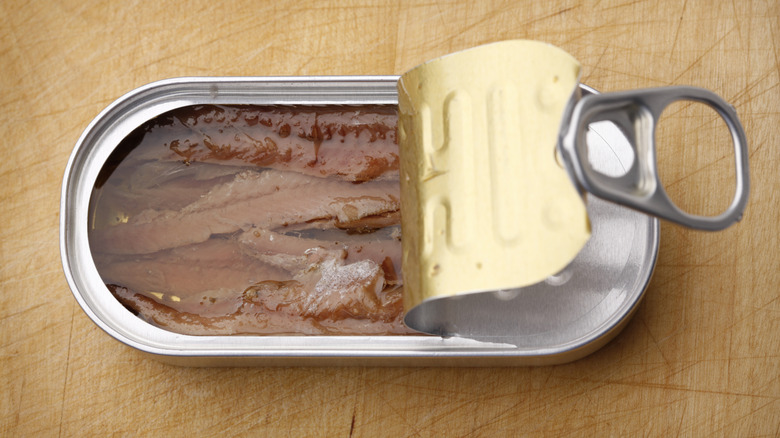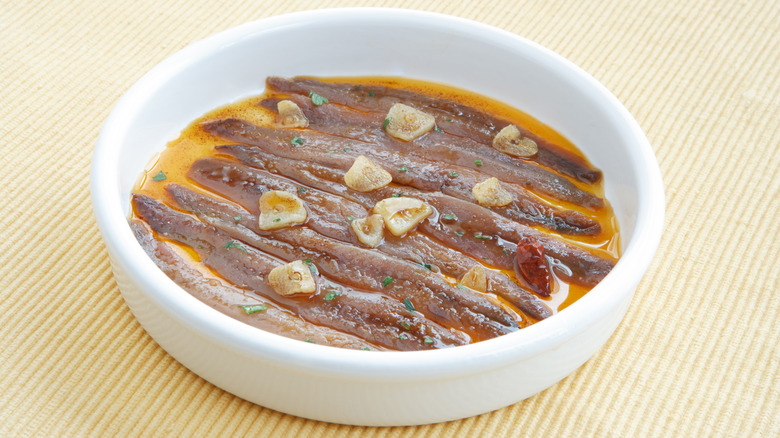Are Canned Anchovies Raw Or Cooked?
Ask people to name a food that they just can't eat, and you'll often get a similar set of answers: Blue cheese, Brussels sprouts, the ever-controversial pizza with pineapple – you get the idea. But one particular food seems to get a disproportionate amount of derision, particularly in the States: anchovies. Fresh or canned, these salty little beauties, while beloved in Europe, just can't seem to catch a break. And that's a shame, because they're actually really quite delicious.
Canned anchovies, in particular, are a versatile ingredient that (while perhaps not an ideal snack all on their own) are capable of delivering a sucker punch of salty flavor, whether in pastas, salads, sauces, or atop some crusty bread with a good glug of olive oil. But there seems to be a little confusion over what canned anchovies actually are — are they raw? Cooked? Pickled, even? The answer lies somewhere in between.
You see, while tuna or sardines are cooked before they're canned, anchovies are cured. In case you're wondering what that is, allow us to explain. Curing is a process of preserving fish or meat using a mixture of salt and sugar, effectively making it safe to eat without cooking it, and preserving the freshness and flavor. In the case of anchovies, the fish are preserved in salt before being canned, which gives them their signature ultra-salty flavor. It also breaks down the proteins, making the anchovies easy to grind up to use in sauces and dressings.
How to cure your own anchovies at home
If you fancy having a go at making your own salt-cured anchovies at home, then you're in luck — they're extremely easy. While they might not last as long as the canned ones, they're just as delicious (if not more so) and can make for a fun and fascinating project for the home cook who likes a bit of experimentation.
All you need are anchovies (of course), some good quality extra virgin olive oil, lots and lots of salt, and a good amount of patience. Fair warning — they take around three months to fully cure, so if you're in a pinch, you'll definitely want to use the store-bought option instead. Alternatively, try making some boquerones, a classic Spanish tapas dish of fresh anchovies, filleted and marinated in vinegar, olive oil, parsley and garlic.
For both methods, you'll need to get yourself some anchovies — though you might struggle to buy them fresh from the grocery store, your fishmonger should be able to help you out here. You could ask them to clean them up for you, or you could try it yourself. Just take the heads and tails off the fish and gut them before carefully removing the fillets from the bones and rinsing them off. Then, to make the cured version, add a layer of salt to a container, then the anchovies, and then fully cover in salt, going in layers until you've fully coated all the fish. Refrigerate for three months, et voilà! Delicious, homemade cured anchovies.
The best ways to use your canned anchovies
Canned anchovies are a fantastically versatile ingredient, and (if you ask us) an essential kitchen staple. They're perhaps best on toast, prepared either by crushing them up and sautéeing them in olive oil, causing them to melt into a delicious pâté-like consistency which you can spread onto the bread, or by using them whole as a topping. They work wonderfully with lemon, chili, or even an herby compound butter (that's right, they're not just good for steaks).
You could also take advantage of that melting effect and incorporate your anchovies into a delicious homemade pasta sauce. The Neapolitan classic, pasta puttanesca, is the perfect vehicle for anchovies' intense salty kick. But you could simply melt them down before tossing into a pesto or aglio e olio, and take advantage of their umami-loaded flavor profile.
Something to keep in mind is how to properly store your anchovies. You might think that because they're canned, they're shelf-stable. This is true — don't panic — but anchovies (unlike other tinned fish) don't go through a pasteurization process before canning. This won't make them unsafe to eat, but it will mean that certain microbes might be present that will survive the curing process, causing a subtle decline in quality over time. To make sure your anchovies stay at their absolute best, keep them in the fridge — even when you haven't opened them yet.



